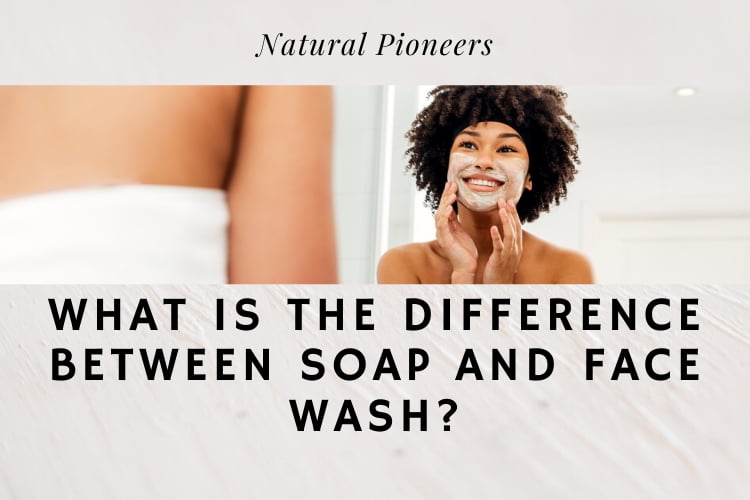
Can you wash your face with soap? Let’s find out and learn about soaps, detergents, pH values, toxins, and more.
Soap is made with fats/oils and lye. Face washes are made with synthetic detergents. Whereas face washes my have a better pH, soap generally contains fewer toxins and may contain 1-20% nourishing “superfat”. Non-toxic, pH-balanced products with hydrating & moisturizing ingredients are ideal.
We’ll start with the basics: the ingredients of soap and face washes.
1. Ingredient Check! Soap Vs. Face Wash
Let’s find out how soap and face wash are made to determine the difference between them.
Generally, there are two main cleaning agents you should know of. First, there is soap. Soap is a combination of fats or oils with an alkali (lye).” [1] All soap – liquid or bar soap – is made during the saponification process. Saponification means “soap making”, and is a chemical reaction that occurs when fats or oils come into contact with an alkali.
You might even know people who make their own soap. Since soap requires little ingredients, soap is an easy and useful thing to create for anyone who’s into DIY.
So, remember, for soap, you need fats or oils and lye.
>> Learn more about natural soap
The second cleaning agent worth mentioning, are synthetic detergents. Both, face washes and cleansers are made with detergents. They are made in chemical plants.
Face washes foam upon application and need to be washed off, while cleansers usually have a lotion-like consistency and can be washed or wiped off.
A common belief is that cleansers are much milder on the skin than a face wash. And that face wash should be used for oily and combination skin. That’s only half the story.
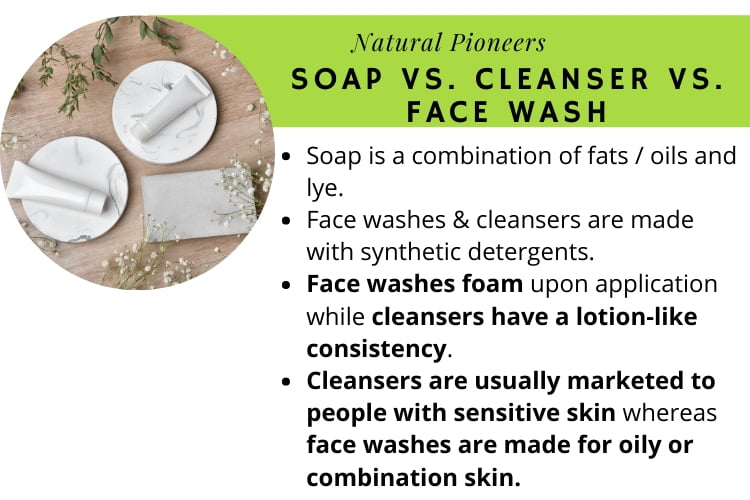
Your skin has complex needs and when the composition of a face wash or cleanser meets those needs, then it really doesn’t matter whether it’s labeled face wash or cleanser. Let’s find out about our skin’s needs next.
The Take-Away: Soap is made through saponification, where fats or oils come in contact with lye. Soap can easily be made at home. Face washes and cleansers, on the other side, are made with synthetic detergents, which are produced in chemical plant.
2. What Is Ideal For Our Face?
According to the University of Washington, here’s what healthy skin looks and feels like:
“Healthy skin is smooth, with no breaks in the surface. It is warm (not hot or red) and neither dry and flaky nor moist and wrinkled. Healthy skin is a mirror of a healthy body.“ [2]
So far, so good, how does soap or a face wash (or cleanser) contribute to healthy skin?
Studies show, that the most important biophysical parameters of healthy skin are the skin pH, epidermal hydration, transepidermal water loss and sebum excretion. [3]
Alright, there we have it. Let’s see what these 4 terms mean and how soaps, face washes (or cleansers) impact them.
A Healthy Skin pH & Sebum Secretion
The pH is a scale used to specify how acidic or basic something is. Anything between 0 and 6.9 is acidic, 7 is neutral and anything between 7.1 and 14 is considered alkaline. Studies show, that normal skin surface pH is between 4 and 5 in healthy people. [4], [5]
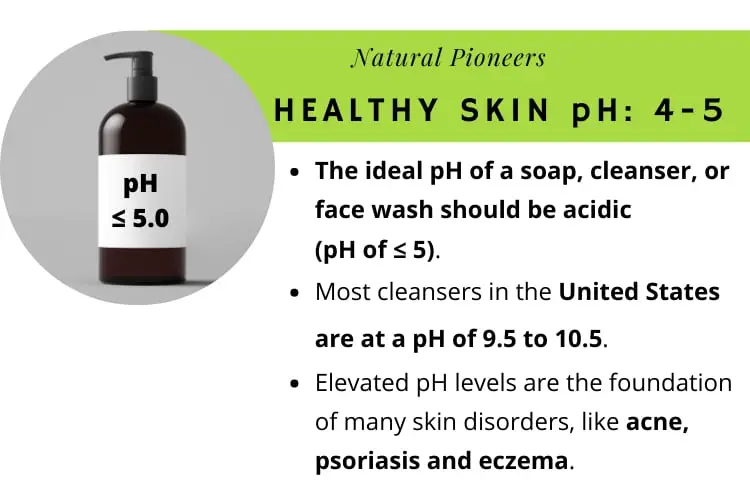
Our skin is the first line of defense against microorganisms, wind, pollutants and more. It is our skins acid mantle that really does the job. The acid mantle is a fine film with a slightly acidic pH on the surface of the skin and provides ideal protection.
So far, we’ve learned that our skin is naturally acidic. It probably comes as no surprise that anything we use to wash our face should not disturb the protective acid mantle.
The ideal pH of a cleaning product (soap, face wash, or cleanser) should be acidic, that means it should have a pH of ≤ 5. [6]
However, the market in the United States carries very few low-pH soaps, cleansers, and face washes. In fact, most cleansers in the United States are at a pH of 9.5 to 10.5. [7]
Since soaps are made with an alkali (lye), their pH is naturally more on the alkaline side. For cleansers, and face washes, they can be composed in a way that results in a neutral or acidic pH, which is preferable.
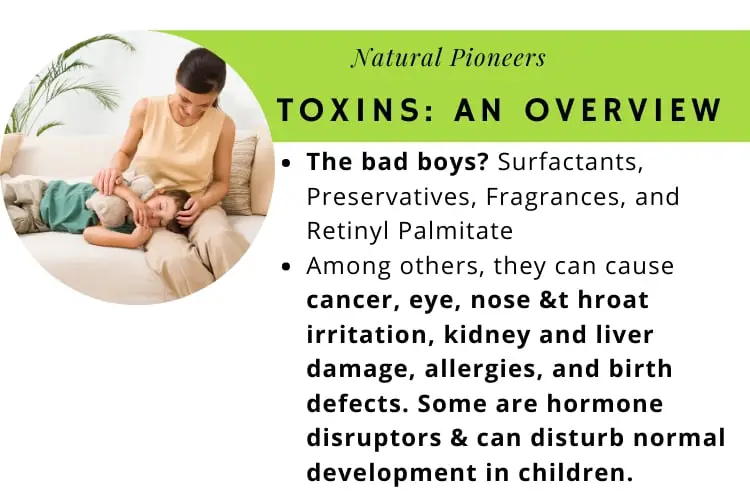
>> Learn more about the pH of shampoos
Another aspect to consider are chemicals in our personal care products. In short, toxins which you’ll find primarily in cleansers and face washes (less often in soaps) can cause harm to your skin and overall health. Products made with surfactants, preservatives, fragrances, or retinyl palmitate can seriously harm our health. Among others, they can cause eye, nose, and throat irritation, kidney and liver damage, allergies, are hormone disruptors, and can cause cancer. [8], [9], [10], [11], [12], [13], [14], [15], [16], [17]
>> Read more about toxins in face washes and cleansers here
“Soap isn’t necessarily bad for acne, but the wrong type of soap or cleanser can irritate the skin, making acne worse or making it difficult to use appropriate acne medications — many of which are drying.” [18]
Dr. Kathleen Welsh, board-certified Dermatologist
The Take-Away: When it comes to the pH of a product, most soaps, face washes, and cleansers are not formulated to meet our skins needs. Very few products have an ideal pH of ≤ 5. Cleansers and face washes can be made with ingredients resulting in an acidic pH whereas soap is naturally more on the alkaline side. As far as toxins are concerned, soap is usually less impacted whereas many cleansers and face washes contain lots of chemicals that can harm our skin and health.
>> Here you can find non-toxic cleansers and face washes with an ideal pH of ≤ 5
Epidermal Hydration & Transepidermal Water Loss
Our skin has the ability to stay hydrated by itself. Water originates in the deeper skin layers and moves upward to hydrate all layers of our skin. The key is to keep it there and not lose the hydration. Dermatologists often use the term TEWL (transepidermal waterloss) which is the amount of water that passively evaporates through skin to the external environment.
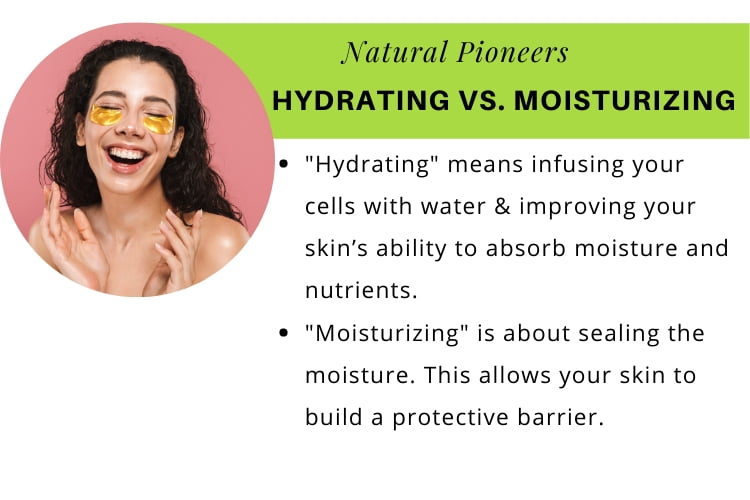
Face washes, cleansers and soaps can all be made with ingredients that support hydration & moisture. Hydrating means infusing our skin with water & improving our skin’s ability to absorb moisture and nutrients. Whereas moisturizing is about sealing the moisture. This allows your skin to develop a protective barrier. [19]
Here are the skin beneficial ingredients to look for. [20]
Hydrating Ingredients:
- Hyaluronic Acid
- Glycerin
- Aloe
- Honey
- Snail Mucin
- Lactic Acid
- Citric Acid
Moisturizing Ingredients:
- Nut or Seed Oil (Coconut, Almond, Hemp…)
- Shea Butter
- Plant Oils (Jojoba, Rose Hip, Tea Tree)
- Mineral Oil
- Lanolin
- Lactic Acid
- Citric Acid
Soap naturally contains glycerin as it is a by-product of saponification. Moreover, many natural soap producers use a process called superfatting in which they either add an extra amount of oil or reduce the amount of lye resulting in about 1-20% extra nourishing “superfat”.
The Take-Away: Hydration & moisture are important for our skin’s health. Depending on the formulation, face washes and cleansers may or may not include valuable hydrating and moisturizing ingredients. However, natural soap contains glycerin as it is a by-product of saponification. Make sure to look for natural soaps, as many popular brands extract glycerin to use it in lotions and creams. Additionally, many natural soap producers use a process called superfatting in which they either add an extra amount of oil or reduce the amount of lye resulting in about 1-20% extra nourishing “superfat”.
>> You can find natural soaps with glycerin here
3. The Big Comparison: Soap Vs. Face Wash
We’ve learned a lot about soaps, face washes and cleansers so far. Now, let’s summarize the facts and compare them.
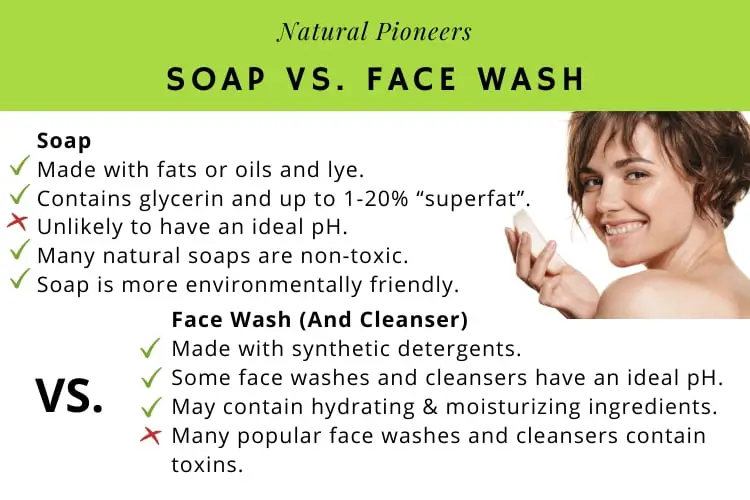
Soap Facts
- Made with simple ingredients: Fats or oils and lye & easy to make at home.
- A good (natural) soap contains glycerin and 1-20% of nourishing “superfat”. [21]
- Unlikely to have an ideal pH.
- Bar soap generally contains significantly fewer toxins, many natural soaps are non-toxic.
- When considering the carbon footprint, bar soap is generally wrapped in eco-friendly paper and requires less packaging material. Moreover, it is more efficient to transport and requires significantly fewer raw materials.
Face Wash (And Cleanser) Facts
- Made with synthetic detergents.
- Some face washes and cleansers have an ideal pH.
- May or may not contain hydrating & moisturizing ingredients for skin health
- Many popular face washes and cleansers are toxic for our health
>> Here you can find non-toxic cleansers and face washes with an ideal pH and moisturizing and hydrating ingredients.
4. Conclusion
Soap is made through saponification, where fats or oils come in contact with lye. Soap can easily be made at home. Face washes and cleansers, on the other hand, are made with synthetic detergents, which are produced in chemical plant.
As far as the pH of a product is concerned, most soaps, face washes, and cleansers are not formulated to meet our skins needs. Very few products have an ideal pH of ≤ 5. Cleansers and face washes can be made with ingredients resulting in an acidic pH whereas soap is naturally more on the alkaline side.
Soap is usually less impacted by toxic ingredients, whereas many cleansers and face washes contain lots of chemicals that can harm our skin and health.
Hydration & moisture are important for our skin’s health. Depending on the formulation, face washes and cleansers may or may not include valuable hydrating and moisturizing ingredients. However, natural soap contains glycerin as it is a by-product of saponification. Make sure to look for natural soaps, as many popular brands extract glycerin to use it in lotions and creams. Additionally, many natural soap producers use a process called superfatting in which they either add an extra amount of oil or reduce the amount of lye resulting in about 1-20% extra nourishing “superfat”.
In conclusion, non-toxic, pH-balanced products with hydrating & moisturizing ingredients are ideal for our skin. Certain face washes and cleansers meet these criteria. Despite the fact that soap is the more natural product, soap is unlikely to show ideal pH levels for our skin.

